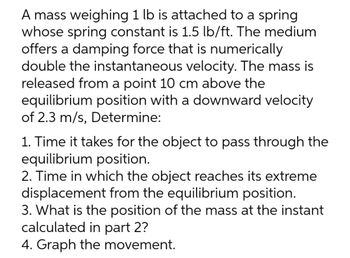Question

Transcribed Image Text:A mass weighing 1 lb is attached to a spring
whose spring constant is 1.5 lb/ft. The medium
offers a damping force that is numerically
double the instantaneous velocity. The mass is
released from a point 10 cm above the
equilibrium position with a downward velocity
of 2.3 m/s, Determine:
1. Time it takes for the object to pass through the
equilibrium position.
2. Time in which the object reaches its extreme
displacement from the equilibrium position.
3. What is the position of the mass at the instant
calculated in part 2?
4. Graph the movement.
Expert Solution
This question has been solved!
Explore an expertly crafted, step-by-step solution for a thorough understanding of key concepts.
Step by stepSolved in 3 steps with 3 images

Knowledge Booster
Similar questions
- 1) A student suspends a 0.3 kg mass from an ideal spring and measures the equilibrium displacement of the spring to be 5.5 cm. Calculate the spring constant. 2) She then gently pulls the mass down and releases it, so it oscillates harmonically. a) Calculate the angular frequency of oscillation. b) Calculate the period of oscillation. c) Calculate the number of cycles the oscillating mass complete every second.arrow_forward(hrw8c15p89) A vertical spring stretches 7.4 cm when a 2.0 kg block is hung from its end. Calculate the spring constant. Submit Answer Tries 0/5 This block is then displaced an additional 5.5 cm downward and released from rest. Find the period. Submit Answer Tries 0/5 Find the frequency. Submit Answer Tries 0/5 Find the amplitude ( cm). Submit Answer Tries 0/5 Find the maximum speed of the resulting SHM ( cm/s). Submit Answer Tries 0/5arrow_forwardA vertical spring has a 0.463-kg block hung from it, and you wait till the spring comes to rest at reaches an equilibrium. The spring is now 0.694 meters longer. What is the spring constant of the spring? spring constant: N/m You gently pull the block down an additional0.346 m and hold the block at rest. Then releasing the block, and assuming no damping, what is the period of oscillation of the block-spring system? period of oscillation: S How high above the point of release does the block reach as it oscillates? height: .694 marrow_forward
- A lightly damped harmonic oscillator, with a damping force proportional to its speed, is oscillatingwith an amplitude of 0.500 cm at time t = 0. When t = 8.20 s, the amplitude has died down to 0.400cm. At what value of t will the oscillations have an amplitude of 0.250 cm?A) 16.5 s B) 20.5 s C) 5.13 s D) 18.5 s E) 25.5 sarrow_forwardA 0.65 kg body when attached to a spring of force constant 225 N/m oscillates with an amplitude of 0.15m. Find the a.) velocity and b.) acceleration of the mass when it passes its equilibrium position.arrow_forwardA 364-g object is attached to a spring and executes simple harmonic motion with a period of 0.240 s. If the total energy of the system is 4.67 J, find the following. (a) the maximum speed of the object 249 Your response differs significantly from the correct answer. Rework your solution from the beginning and check each step carefully. m/s (b) the force constant of the spring N/m (c) the amplitude of the motion Need Help? Read It Watch Itarrow_forward
- QUESTION 12 A 0.25-kg harmonic oscillator has a total mechanical energy of 4.1 J. If the oscillation amplitude is 20.0 cm, what is the oscillation frequency, in hertz?arrow_forwardA pendulum swings between extreme angles -a and a it relative to the equilibrium. As it passes through the point at the angle of a/2 w.r.t. the equilibrium, how is its instantaneous speed v related to the maximum speed of the oscillation?arrow_forwardA spring mass system has a period of 2.4 us when its amplitude is 1.6 CM if the amplitude is tripled what will the numerical value of the period be state unit arrow_forward
- A concrete block is hung from an ideal spring that has a force constant of 200 N/m. The spring stretches 0.120m. A) what is the mass of the block? B) what’s is the period of oscillation of the block if it is pulled down 1.0 cm and released? C) what would be the period of oscillation if the block and spring were placed on the moon?arrow_forwardChapter 6 Applications of Linear Second Order Equations 288 6.2 Exercises 4. A 96 lb weight stretches a spring 3.2 ft in equilibrium. It is attached to a dashpot with damping constant c-18 lb-sec/ft. The weight is initially displaced 15 inches below equilibrium and given a downward velocity of 12 ft/sec. Find its displacement for t > 0arrow_forwardA 4.0-kg block executes simple harmonic motion according to the following equation for the position as a function of time: x(t) = (0.60 m)cos(5t) What is the mechanical energy of the oscillator? a. 18 J b. 22 J c. 20 J d. 16 J e. 14 Jarrow_forward
arrow_back_ios
SEE MORE QUESTIONS
arrow_forward_ios